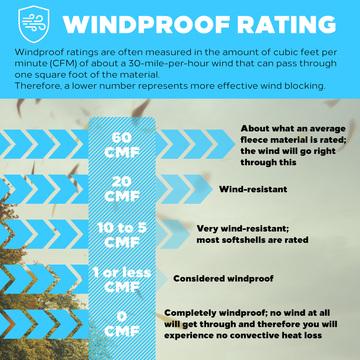
How are windproof capabilities measured for clothing?
In the United States, windproof ratings are often measured in the amount of cubic feet per minute (CFM) of about a 30-mile-per-hour wind that can pass through one square foot of the material. Therefore, a lower number represents more effective wind blocking.
When choosing from our rain gear collection, you'll find the best quality and selection.
Here’s an outline for the practical application of these numbers:
- 60 CMF – about what an average fleece material is rated; the wind will go right through this.
- 20 CFM – wind-resistant.
- 10 to 5 CFM – very wind-resistant; what most softshells are rated.
- 1 CFM or less – considered windproof.
- 0 CFM – completely windproof; no wind at all will get through and therefore you will experience no convective heat loss.

There’s actually an easy way to test this. Simply hold the fabric against your mouth and blow against it as hard as you can. An average adult can generate a maximum pressure of approximately 2 pounds per square inch this way, which is roughly the equivalent of a 20 mph wind. If you can feel your breath coming through the fabric (or not), you thus have a good gauge for its effectiveness. Likewise if your breath passes through easily (low wind-resistance) or with difficulty (moderate wind-resistance).
Wind-resistant versus windproof follows the same lines as water-resistant versus waterproof. Wind-resistant means that the gear will provide a barrier against air penetrating the material and chilling your skin. ... However, windproof means that no wind will penetrate the material.
As a general rule, the more wind-resistant a fabric is, the less breathable it becomes. This can result in substantial sweating, especially if you’re active in a wind-proof jacket, and doubly so if you’re wearing a wind-proof layer under a Gore-Tex jacket.

Lightweight and packable in nature, the main purpose of windproof jackets is to help keep the chill of the wind off you while also preventing you from overheating when exerting yourself. Waterproof shells, no matter how breathable they may be, will tend to be too warm and stuffy in all but the coldest environments, whereas windproof jackets allow for more breathability.
They’re also helpful for throwing on when you take a break to help prevent you from cooling down too much. A good windproof jacket will keep you comfortable for a wide range of outdoor activities and conditions. -WR
